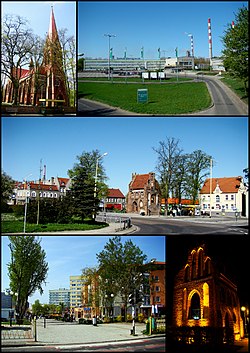Police, Poland
| Police | |||
|---|---|---|---|

Police; Top left: Saint Mary's Church, Top right: Kuznicka industrial complex area, Center: Rynek Square, Bottom left: Anny Jagiellonki New Town, Bottom right: A night view of a gothic chapel in Chrobry Square
|
|||
|
|||
| Coordinates: 53°32′N 14°34′E / 53.533°N 14.567°E | |||
| Country |
|
||
| Voivodeship | West Pomeranian | ||
| County | Police County | ||
| Gmina | Gmina Police | ||
| Government | |||
| • Mayor | Władysław Diakun | ||
| Area | |||
| • Total | 36.84 km2 (14.22 sq mi) | ||
| Population (2014) | |||
| • Total | 41,745 | ||
| • Density | 1,100/km2 (2,900/sq mi) | ||
| Time zone | CET (UTC+1) | ||
| • Summer (DST) | CEST (UTC+2) | ||
| Postal code | 72-009, 72-010, 72-011 | ||
| Car plates | ZPL | ||
| Website | http://www.police.pl | ||
Police [pɔˈlʲit͡sɛ] (German: Pölitz; Kashubian/Pomeranian: Pòlice) is a town in the West Pomeranian Voivodeship, northwestern Poland. It is the capital of Police County. As of 2007[update], the town had 34,220 inhabitants. This is one of the biggest towns of Szczecin agglomeration.
The town is situated on the Oder River and its estuary, south of the Szczecin Lagoon and the Bay of Pomerania. The centre of Police Town is situated about 15 kilometres (9 miles) north of the centre of Szczecin.
The name of the town comes from the Slavic pole, which means "".
The settlement was first mentioned in 1243. Pomeranian duke Barnim of Pomerania granted Magdeburg law to the town in 1260. At the end of the 13th century, the town had become a fief of a local dynasty of knights, the Drake family. In 1321, with the death of Otto Drake, the town became a dependency of nearby Stettin (now Szczecin), hindering its growth until the mid-18th century.
Nearby Jasienica Abbey, now within the Police city limits, was secularized during the Protestant Reformation, which was adapted in the Duchy of Pomerania in 1534. After its secularization, the abbey became a ducal domain, and was the site of the treaty that for the first time partitioned the duchy into a western and eastern part (Pomerania-Wolgast and Pomerania-Stettin) in 1569.
...
Wikipedia



